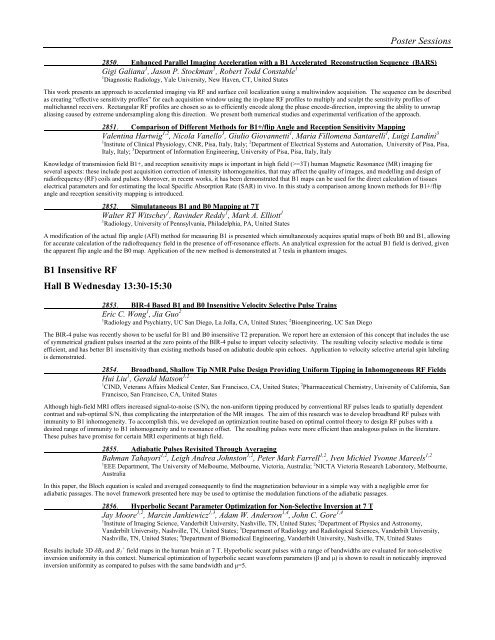TRADITIONAL POSTER - ismrm
TRADITIONAL POSTER - ismrm
TRADITIONAL POSTER - ismrm
Create successful ePaper yourself
Turn your PDF publications into a flip-book with our unique Google optimized e-Paper software.
Poster Sessions<br />
2850. Enhanced Parallel Imaging Acceleration with a B1 Accelerated Reconstruction Sequence (BARS)<br />
Gigi Galiana 1 , Jason P. Stockman 1 , Robert Todd Constable 1<br />
1 Diagnostic Radiology, Yale University, New Haven, CT, United States<br />
This work presents an approach to accelerated imaging via RF and surface coil localization using a multiwindow acquisition. The sequence can be described<br />
as creating “effective sensitivity profiles” for each acquisition window using the in-plane RF profiles to multiply and sculpt the sensitivity profiles of<br />
multichannel receivers. Rectangular RF profiles are chosen so as to efficiently encode along the phase encode-direction, improving the ability to unwrap<br />
aliasing caused by extreme undersampling along this direction. We present both numerical studies and experimental verification of the approach.<br />
2851. Comparison of Different Methods for B1+/flip Angle and Reception Sensitivity Mapping<br />
Valentina Hartwig 1,2 , Nicola Vanello 3 , Giulio Giovannetti 1 , Maria Fillomena Santarelli 1 , Luigi Landini 3<br />
1 Institute of Clinical Physiology, CNR, Pisa, Italy, Italy; 2 Department of Electrical Systems and Automation, University of Pisa, Pisa,<br />
Italy, Italy; 3 Department of Information Engineering, University of Pisa, Pisa, Italy, Italy<br />
Knowledge of transmission field B1+, and reception sensitivity maps is important in high field (>=3T) human Magnetic Resonance (MR) imaging for<br />
several aspects: these include post acquisition correction of intensity inhomogeneities, that may affect the quality of images, and modelling and design of<br />
radiofrequency (RF) coils and pulses. Moreover, in recent works, it has been demonstrated that B1 maps can be used for the direct calculation of tissues<br />
electrical parameters and for estimating the local Specific Absorption Rate (SAR) in vivo. In this study a comparison among known methods for B1+/flip<br />
angle and reception sensitivity mapping is introduced.<br />
2852. Simulataneous B1 and B0 Mapping at 7T<br />
Walter RT Witschey 1 , Ravinder Reddy 1 , Mark A. Elliott 1<br />
1 Radiology, University of Pennsylvania, Philadelphia, PA, United States<br />
A modification of the actual flip angle (AFI) method for measuring B1 is presented which simultaneously acquires spatial maps of both B0 and B1, allowing<br />
for accurate calculation of the radiofrequency field in the presence of off-resonance effects. An analytical expression for the actual B1 field is derived, given<br />
the apparent flip angle and the B0 map. Application of the new method is demonstrated at 7 tesla in phantom images.<br />
B1 Insensitive RF<br />
Hall B Wednesday 13:30-15:30<br />
2853. BIR-4 Based B1 and B0 Insensitive Velocity Selective Pulse Trains<br />
Eric C. Wong 1 , Jia Guo 2<br />
1 Radiology and Psychiatry, UC San Diego, La Jolla, CA, United States; 2 Bioengineering, UC San Diego<br />
The BIR-4 pulse was recently shown to be useful for B1 and B0 insensitive T2 preparation. We report here an extension of this concept that includes the use<br />
of symmetrical gradient pulses inserted at the zero points of the BIR-4 pulse to impart velocity selectivity. The resulting velocity selective module is time<br />
efficient, and has better B1 insensitivity than existing methods based on adiabatic double spin echoes. Application to velocity selective arterial spin labeling<br />
is demonstrated.<br />
2854. Broadband, Shallow Tip NMR Pulse Design Providing Uniform Tipping in Inhomogeneous RF Fields<br />
Hui Liu 1 , Gerald Matson 1,2<br />
1 CIND, Veterans Affairs Medical Center, San Francisco, CA, United States; 2 Pharmaceutical Chemistry, University of California, San<br />
Francisco, San Francisco, CA, United States<br />
Although high-field MRI offers increased signal-to-noise (S/N), the non-uniform tipping produced by conventional RF pulses leads to spatially dependent<br />
contrast and sub-optimal S/N, thus complicating the interpretation of the MR images. The aim of this research was to develop broadband RF pulses with<br />
immunity to B1 inhomogeneity. To accomplish this, we developed an optimization routine based on optimal control theory to design RF pulses with a<br />
desired range of immunity to B1 inhomogeneity and to resonance offset. The resulting pulses were more efficient than analogous pulses in the literature.<br />
These pulses have promise for certain MRI experiments at high field.<br />
2855. Adiabatic Pulses Revisited Through Averaging<br />
Bahman Tahayori 1,2 , Leigh Andrea Johnston 1,2 , Peter Mark Farrell 1,2 , Iven Michiel Yvonne Mareels 1,2<br />
1 EEE Department, The University of Melbourne, Melbourne, Victoria, Australia; 2 NICTA Victoria Research Laboratory, Melbourne,<br />
Australia<br />
In this paper, the Bloch equation is scaled and averaged consequently to find the magnetization behaviour in a simple way with a negligible error for<br />
adiabatic passages. The novel framework presented here may be used to optimise the modulation functions of the adiabatic passages.<br />
2856. Hyperbolic Secant Parameter Optimization for Non-Selective Inversion at 7 T<br />
Jay Moore 1,2 , Marcin Jankiewicz 1,3 , Adam W. Anderson 1,4 , John C. Gore 1,4<br />
1 Institute of Imaging Science, Vanderbilt University, Nashville, TN, United States; 2 Department of Physics and Astronomy,<br />
Vanderbilt University, Nashville, TN, United States; 3 Department of Radiology and Radiological Sciences, Vanderbilt University,<br />
Nashville, TN, United States; 4 Department of Biomedical Engineering, Vanderbilt University, Nashville, TN, United States<br />
Results include 3D δB 0 and B 1 + field maps in the human brain at 7 T. Hyperbolic secant pulses with a range of bandwidths are evaluated for non-selective<br />
inversion uniformity in this context. Numerical optimization of hyperbolic secant waveform parameters (β and μ) is shown to result in noticeably improved<br />
inversion uniformity as compared to pulses with the same bandwidth and μ=5.















